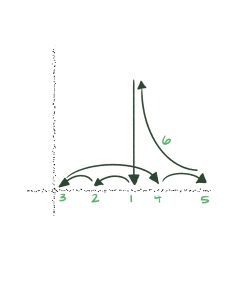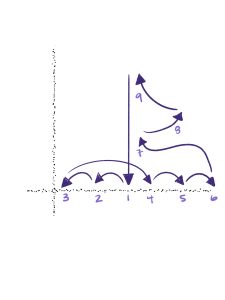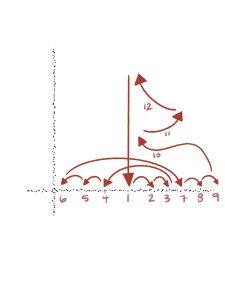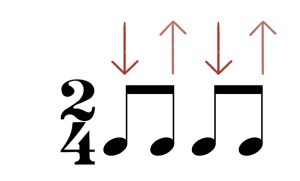8 Compound Meter Beat Patterns
George Shannon, II
Learning Objectives
In this chapter, students will:
- Articulate the difference between simple and compound meters.
- Aurally identify whether a piece of music uses a simple or compound meter.
- Conduct exercises using compound meters individually and to an ensemble in fast and slow patterns.
Listen to the first 15-20 seconds of the following selections to determine whether the music is in a simple or compound meter. Suggestion: Start first by tapping the steady beat, then try to divide evenly into two or three pieces. Listen in particular to the background accompaniment. Identify elements that suggest simple or compound meter such as rhythmic structure, feeling, strong vs. weak beats, etc.
Defining Simple and Compound Meters
Understanding the Components of Simple Meter
Simple meter is defined as a time signature that divides the beat into two pieces. The first division of the beat is considered the “strong” or “accented” beat while the second division is the “weak” or “unaccented” beat. As noted in Chapter 2, the top number of a time signature in a simple meter indicates how many beats are in the measure, with the bottom number corresponding to what kind of note represents the beat.
Duple, Triple, and Quadruple Simple Meters
Simple meters are classified into three categories which correspond to the number of groupings in the measure: duple, triple, and quadruple. For example, a simple triple meter would be 3/4 time signature: “simple” due to the beats being divided into two pieces, and “triple” because each pair are coupled to make three groups. Therefore, a simple duple meter would have two groups and a simple quadruple meter would have four. Below is a table with examples of simple meters:

Understanding the Components of Compound Meters
Compound meters, such as 6/8 or 12/4, divide the beat into three parts instead of two. The first part of the beat is strong, or “accented”, and the latter two parts are weak, “unaccented.”

As with simple meters, compound meters can be duple, triple, or quadruple. See the table below which contains examples of compound meters:

Conducting Compound Meters
Defining “Fast” and “Slow” Conducting Pattern Shapes
Depending on the tempo of the song or work, the conductor will decide whether to use a “fast” or “slow” conducting pattern shape. The “fast” pattern will show the overall beat structure as the tempo would be too brisk to show each individual division. Generally, tempos that exceed Andante would use the “fast” pattern shape. Conversely, tempos that are slower than Andante, such as Largo or Grave should use the “slow” pattern shapes. The reason for using the “slow” pattern shapes is that the ensemble will need more beat clarification. Therefore, you may be required to show the ensemble each division of the beat. For example, if a piece of music is in 9/8 and marked Largo, instead of conducting the three dotted-quarter notes (which shows the overall beat structure), you would conduct a pattern that has nine parts, showing each eighth note. The difference between the fast and slow beat patterns is based on the overall beat structure, or the “feeling.” Keep in mind that, as the conductor, you are at liberty to use the patterns that best meet the needs of your ensemble.
When using a “fast” conducting pattern shape, the conductor will utilize the two, three, and four pattern shapes from Chapter 2 of this text. Therefore, you will conduct the overall beat structure. Example: When conducting a “fast” 6/8, you will use a two-pattern shape as the overall beat structure is a dotted-quarter note. Each measure will contain two dotted-quarter notes as a compound duple time signature. In a “slow” pattern shape, the conductor is showing each division of the beat. Remember, in compound meters, the bottom number in the time signature indicates the type of note that divides the beat. Therefore, a “slow” pattern shape for 6/8 would show six beats to show each eighth note.
Conducting “Fast” Pattern Shapes
The following table presents the time signatures and the appropriate “fast” pattern shape. These conducting shapes are familiar to you as they are the same when conducting in 2/4, 3/4, and 4/4. The difference is that you are now conducting the overall beat structure which contains three subdivisions of the beat. Additionally, conducting in compound meters carries more bounce, or air, between each beat. As noted earlier in this chapter, the first part of the beat is strong followed by two weaker pieces; therefore, the conductor should emphasize the arrival point more greatly than when traveling between gestures.

Suggested Practice 1
Practice Tips:
- When possible, practice in front of a mirror.
- Record yourself. Watch and make note of areas for improvement, then record again.
- Use a metronome. Start with a comfortable tempo and increase gradually.
Practice Activity 1:
- Conduct each pattern shape (2, 3, and 4) with a metronome at the following tempos:
- 76 bpm
- 108 bpm
- 120 bpm
- Subdivide aloud using Takadimi syllables (TaKiDa)
Practice Activity 2:
- With a partner, Person A will conduct each pattern shape with a metronome, and Person B will say various time signatures from the table above Person A will conduct the time signatures without stopping, fluidly maneuvering between each one that is called.
- Practice this exercise at both 76 bpm and 108 bpm
Practice Activity 3:
- Write a four-measure rhythmic exercise that contains two parts and assign body percussion to your peers (groups of 3 – 4). Conduct the exercise, providing one opportunity to cue and one dynamic change.
Conducting Competency 1: Conducting “Fast” Compound Meters
- Part 1: Write a rhythmic exercise consisting of one compound meter, two parts, four measures in length, and Moderato in tempo. Two opportunities for cues should be provided and at least one dynamic change. Be sure to indicate all elements of musical notation, including time signature, tempo, bar lines, etc.
- Part 2: Conduct this exercise with the ensemble (class) using body percussion (claps, pats, snap, etc) or a percussion sounds app specified by the instructor.
Conducting “Slow” Pattern Shapes
When using “slow” pattern shapes, be reminded that you are conducting the division of each beat. In music, the composer may denote the tempo for the specific division, such as 60 beats per minute (bpm), with the following graphic: ![]()
While there may be extra divisions of the beat to conduct, the shape will resemble the four-pattern. When learning shapes in 6, 9, and 12, be sure to take note of the direction of travel and where each piece is placed within the total pattern shape. In each pattern, the rebound of beat one moves away from the next big beat. For example, in 6/8,



Suggested Practice 2
Practice Activity 1
- On a whiteboard or a sheet of paper, practice drawing each pattern shape with your eyes open and closed, showing divisions of 6, 9, and 12. Have a classmate review your work and provide feedback/feedforward.
Practice Activity 2
- With a partner, Person A will conduct each pattern shape with a metronome, and Person B will say various time signatures from Table 4. Person A will conduct the time signatures without stopping, fluidly maneuvering between each one that is called.
- Set the tempo to 68 BPM; however, conduct each division of the overall beat structure.
Practice Activity 3
- Write a four-measure rhythmic exercise that contains two parts and assign body percussion to your peers (groups of 3 – 4). Conduct the exercise, providing one opportunity to cue and one dynamic change.
Conducting Competency 2: Conducting “Slow” Compound Meters
- Part 1: Write a rhythmic exercise consisting of one compound meter, three parts, that is four measures long, and INSERT EIGHTH NOTE = 76. Two opportunities for cues should be provided and dynamic(s) noted. Be sure to indicate all elements of musical notation, including time signature, tempo, bar lines, etc.
- Part 2: Conduct this exercise with the ensemble (class) using body percussion (claps, pats, snap, etc) or a percussion sounds app specified by the instructor.
Advanced Practice
Now that you have a deeper understanding of compound meters, listen and conduct to the following examples, identifying the meter and whether you will use the Fast or Slow pattern. Justify your decision with musical examples (tempo, articulation, expressive terms, etc)


